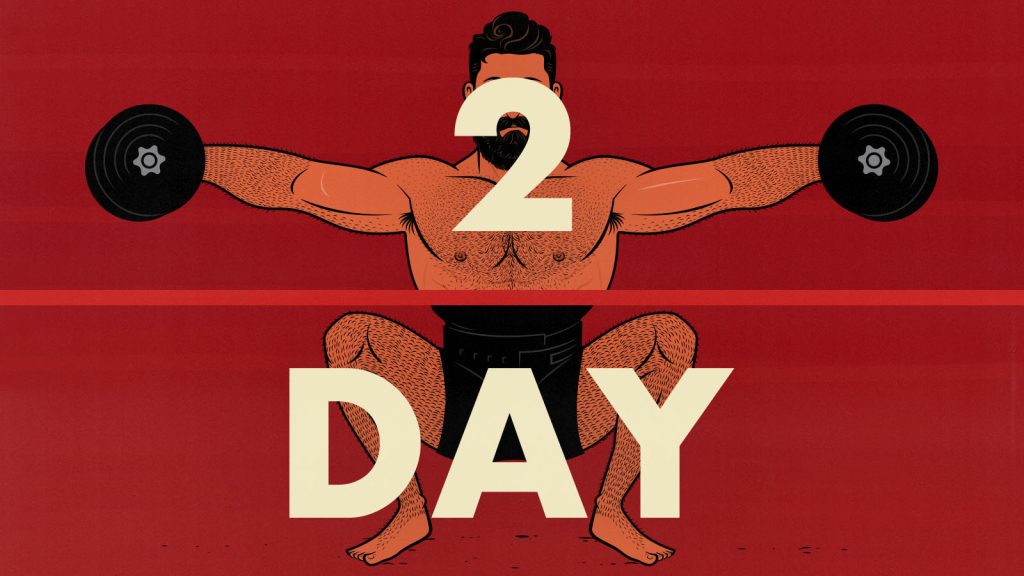
The 2-Day Full-Body Workout Split (For Gaining Muscle)
A two-day workout split is just barely enough to maximize your rate of muscle growth, kind of. To maximize the growth of any one muscle, you need to train it twice per week. That means with two workouts per week, you can maximize your rate of muscle growth in the muscles you train hard in both workouts. The catch is that you won’t be able to train every muscle hard enough in both workouts.
Most people who are serious about building muscle train more than twice a week, but most of them don’t train efficiently. If you’re ruthless with your workout programming and focus on the areas you care about the most, you can get great results.
I’ve gone through long periods of training only twice per week. I’ve gotten some of my best results during those periods. I just had to be very specific with my goals.
- 2-Day Splits are Ideal for Your Health
- 2-Day Splits Are Great for Burning Fat
- The Advantage of Lifting Twice Per Week
- The Downside of Lifting Twice Per Week
- Balanced 2-Day Workout
- Upper Body Emphasis Workout
- Lower-Body Emphasis Workout
- Supersets
- Rest Times
- Reps in Reserve
- Progressive Overload
- How to Eat for Muscle Growth
2-Day Splits are Ideal for Your Health
Lifting weights twice per week is the minimum amount needed to be perfectly healthy. Most research shows that the benefits completely plateau at two workouts per week (study, meta). However, it’s also healthy to be strong and muscular, with dense bones and robust tendons. So, you need to make sure your workout routine is good enough to get you into good shape.
The other nice thing about working out twice per week is that it leaves plenty of time for cardio (and other parts of your life). You need about 8,000 steps per day or about 75–150 minutes of cardio per week before the health benefits start to plateau (study, study). And unlike with weight training, the benefits don’t completely plateau. You get slight benefits from doing even more. Here’s our cardio guide.
So, if you only have a limited amount of time to exercise, and if your main goal is to be healthy, then it’s wise to lift weights twice per week and spend the rest of your time doing cardio.
2-Day Splits Are Great for Burning Fat
Lifting weights while losing weight preserves your muscle mass, allowing you to burn pure fat. A 2-day workout split is just enough to maintain your muscle mass. You could certainly do more, but you don’t have to.
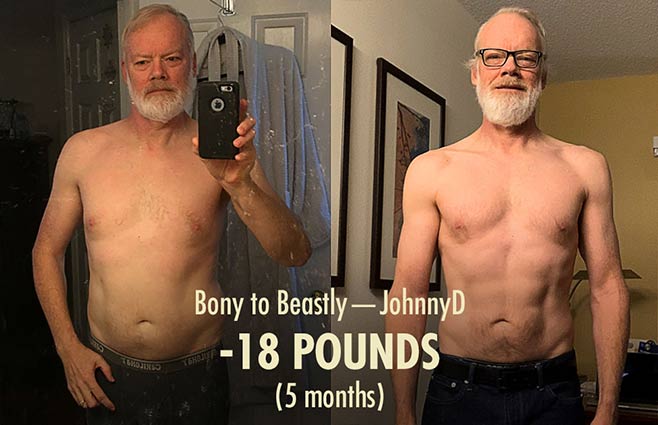
If you’re only lifting weights twice per week, that frees up more time for walking or doing cardio. Walking and cardio burn far more calories than lifting weights, making it easier to get into a sustainable calorie deficit.
If you’re overweight and still relatively new to lifting weights, you can expect to build some muscle while you lose weight. A 2-day split is more than powerful enough to stimulate that muscle growth, especially in the areas you focus on.
The Advantage of Lifting Twice Per Week
The first way to program a 2-day workout split is to balance out the volume between every muscle group, focusing on big compound lifts and being brutally minimalistic. It works well for beginners. It also works well for maintenance. And it’s enough to optimize your general health.
The other option is to train most of your muscles with the bare minimum, freeing up more energy to maximize muscle growth in the few areas you care about the most. Investing your best effort into a few muscles makes it much easier to see consistent progress. You can spend a few months bulking up a few areas and then shift over to other areas.
- Most guys want to build a wider chest, a thicker back, and bigger arms without leaving their legs behind. You can do that by starting both workouts with upper-body pushing and pulling exercises.
- Most women want to build bigger glutes and thicker thighs while also building a reasonably toned upper body. You can do that by starting both workouts with squat, deadlift, and hip thrust variations.
- If you want to focus on getting strong at deadlifts and bench presses, do each of those lifts in both workouts. If you want to be able to do more chin-ups and push-ups, start your workouts with those instead.
You can do everything all at once, but you can do the stuff you care about. In fact, because you have so much time to recover between workouts, it can be even easier to accomplish your primary goals. You won’t be burdened with the fatigue of doing challenging workouts every 1–2 days. You’ll show up to your workouts feeling fresh and recovered.
We usually recommend 3 full-body workouts per week, but if you’re willing to focus on just 2 to 3 goals for the next few months, a 2-day routine can be perfect. You could even split the difference by following a 3-day routine at a slower pace, doing 2 of the workouts every week. That gives you more room for more exercise variety. Here’s our 3-day routine.
The Downside of Lifting Twice Per Week
You won’t be able to maximize the growth of every single muscle. 70 years ago, back in the silver era, some of the best bodybuilders would do compound exercises for every muscle in every workout, doing as many as ten different exercises per workout. But they couldn’t do enough sets per exercise, so they had to train three times per week.
The other problem was that by the time they finished the first few exercises, they were tired, and they didn’t have enough energy to pour into the later exercises. So, they’d put the lifts they cared the least about (usually the lower-body exercises) later in the workout.
If you’re training twice per week, you need to triage even more. If you want overall muscle growth, that might not leave time for isolation exercises like biceps curls and triceps extensions, so your arms won’t grow at full speed.
Or, if you want to focus on building big arms, that might cut into the energy you have for squats and deadlifts. You should still squat and deadlift, but you might do 3–5 sets per week instead of 10–20. Those 3–5 sets won’t be enough to maximize your lower-body growth. More on training volume here.
That’s okay. Your goals can shift. You can accomplish one goal and then maintain it while you focus on another.
Balanced 2-Day Workout
This workout routine is designed for overall muscle growth and the greatest health benefits. It’s an efficient minimalist routine that puts a heavy emphasis on the biggest compound lifts. We’re going to pour most of your effort into squats, deadlifts, presses, and upper-body pulling exercises (like chin-ups and rows). Each workout has one exercise from each category.
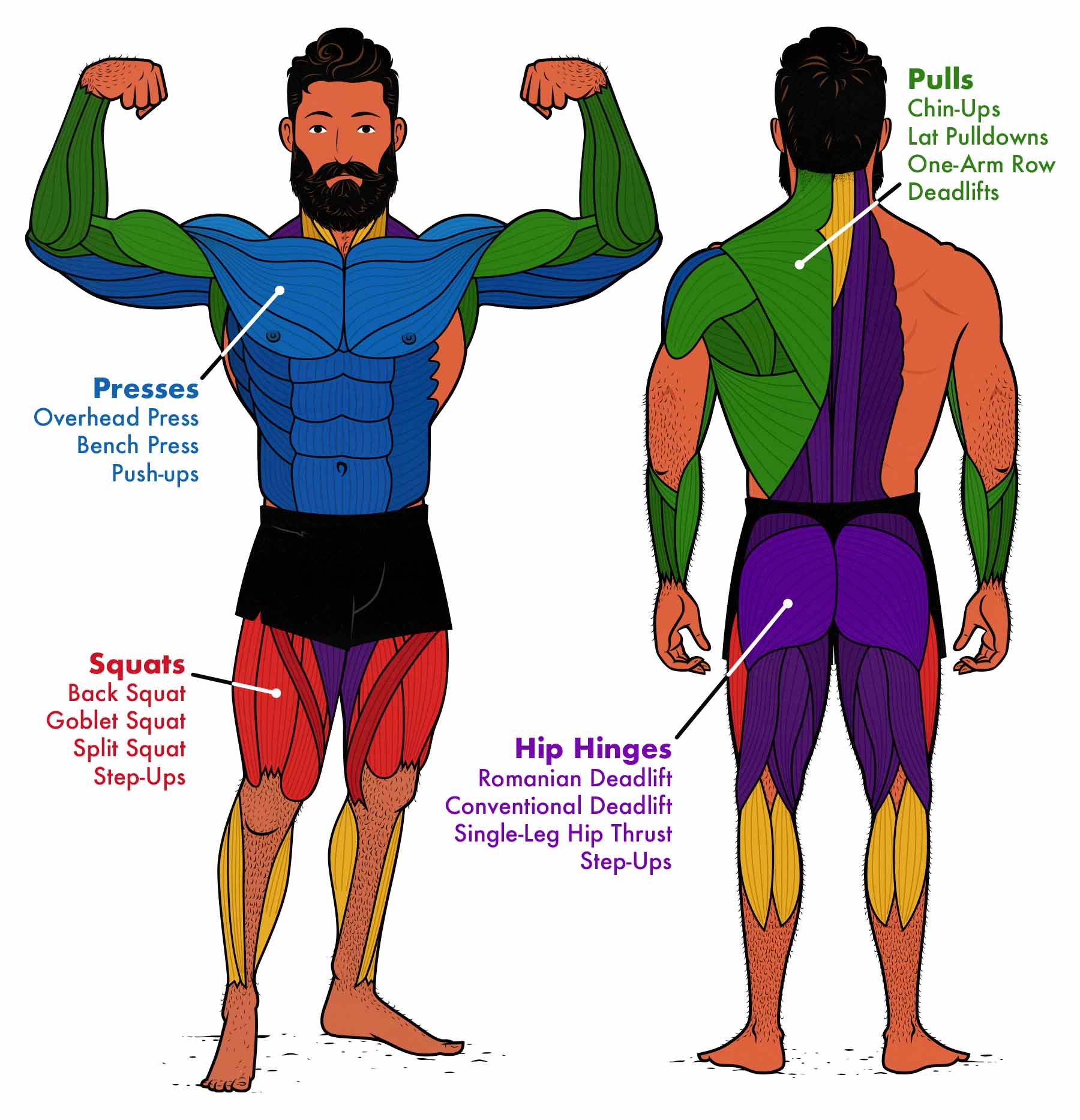
Ideally, you’d do the first workout early in the week (like Monday) and the second workout later in the week (like Thursday). Nothing bad will happen if you need to do them two days in a row, though. If you can only train on the weekends, that’s fine. Your results will be almost as good.
Both workouts are full-body workouts, but they use different overlapping exercises. We want to stimulate most of the muscles in your body each workout, but we also want to get a nice variety of exercises to build a more balanced physique. For example, the first workout has the squat and Romanian deadlift, whereas the second workout has the deadlift and split squat. Both work all the muscles in your legs, just with different exercises.
Start with fewer sets. Full-body workouts can be pretty long. You might need to cut the sets short to get through them. Start with 2-3 sets per exercise and work your way up from there.
Full-Body Workout 1
We’ve organized these exercises so that you can do supersets. You can do a set of Romanian deadlifts, rest for a minute, drop down for a set of push-ups, rest for another minute, and then do your second set of Romanian deadlifts. These supersets are optional, but full-body workouts can get long. You have to keep your pace up. This will help.
| Exercise | Sets | Reps |
|---|---|---|
| Back Squat | 3–5 sets | 6–10 reps |
| One-Arm Overhead Press | 3–5 sets | 8–12 reps/side |
| Romanian Deadlifts | 3–5 sets | 6–12 reps |
| Push-Ups | 2–4 sets | AMRAP |
| One-Arm Row | 2–3 sets | 8–12 reps/side |
| Farmer Carries | 2–3 sets | 40 steps |
This workout focuses on your chest, back, quads, and shoulders. I’ve chosen pairs of exercises that are easy to superset, but choose whatever exercise variations suit you best. Here are my favourite swaps:
- Back Squat: dumbbell goblet squat, front squat, or split squat.
- One-Arm Overhead Press: barbell overhead press or machine press.
- Romanian Deadlift: dumbbell Romanian deadlift or conventional deadlift.
- Push-Ups: dumbbell bench or barbell bench.
- One-Arm Row: bent-over barbell row, seated cable row, or t-bar row.
- Farmer carries: dumbbell farmer carries, dumbbell shrugs, or barbell shrugs.
Full-Body Workout 2
| Exercise | Sets | Reps |
|---|---|---|
| Chin-Up | 3–5 sets | AMRAP |
| Split Squat | 3–5 sets | 8–12 reps/side |
| Deadlift | 2–3 sets | 6–8 reps |
| Push-Ups | 2–3 sets | AMRAP |
| Lat Pulldowns | 2–3 sets | 8–15 reps |
| TYIs | 2–3 sets | 10–15 reps |
This workout focuses on your back, chest, hips, postural muscles, and arms. Here are my favourite exercise swaps:
- Chin-Up: pull-up, lat pulldown, or dumbbell pullover.
- Split Squat: goblet squat, front squat, or leg press.
- Deadlift: sumo deadlift, dumbbell step up, or good morning.
- Push-Ups: raised push-ups, deficit push-ups, or dips.
- Lat Pulldowns: pullovers, pull-ups, or chin-ups.
- TYIs: rear delt fly or cable face-pulls.
Upper Body Emphasis Workout
This 2-day workout is designed for the average guy who wants a strong upper body (without having chicken legs). We’ll start each workout with upper-body pressing and pulling exercises, and we’ll include some isolation exercises for your arms and shoulders. We’ll also include just enough squats and deadlifts to make slow and steady progress.
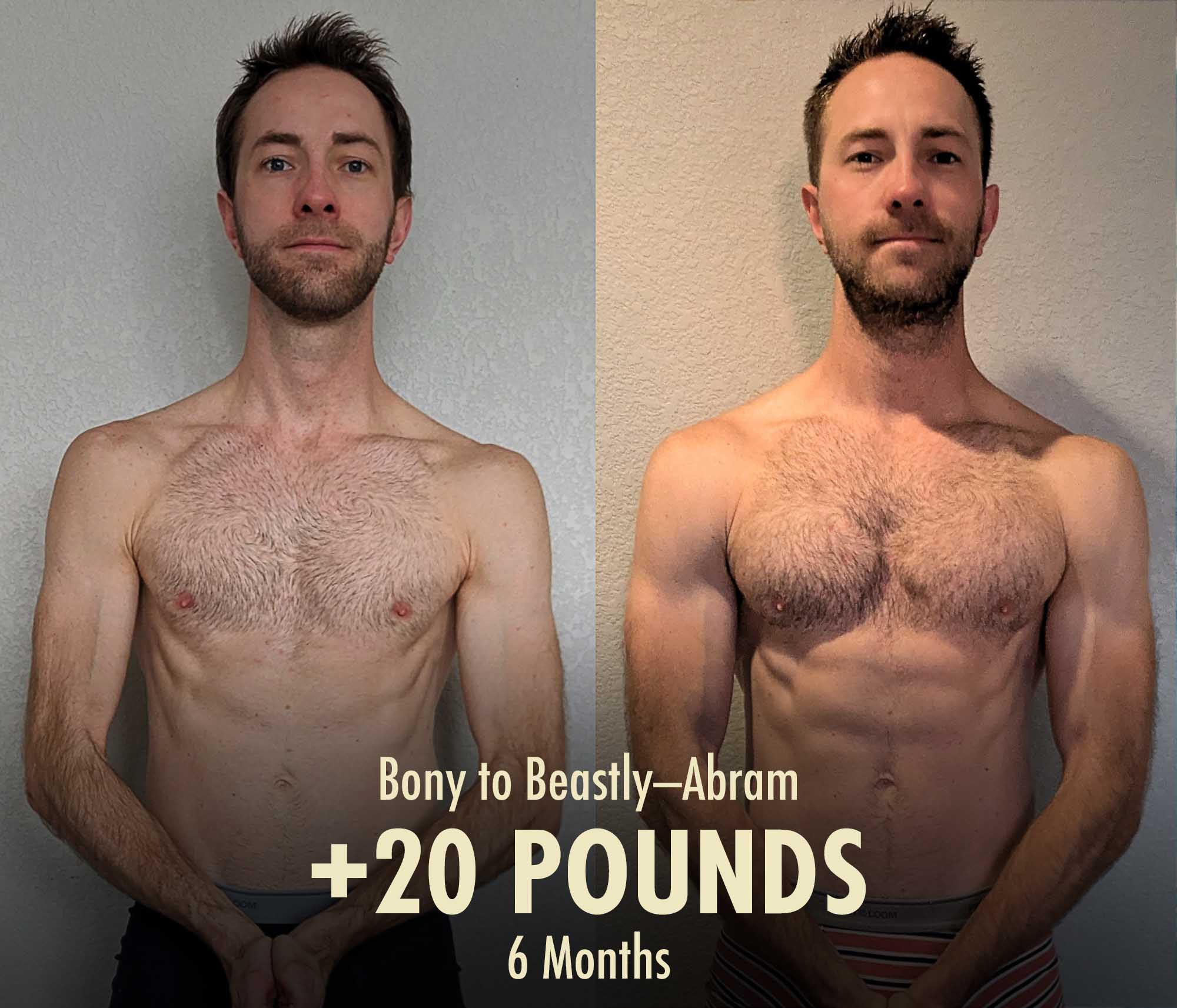
Ideally, you’d do the first workout early in the week (like Monday) and the second workout later in the week (like Thursday). Nothing bad will happen if you need to do them two days in a row, though. Your results will be almost as good.
Both workouts are full-body workouts, but we’re alternating between squats and deadlifts. The first workout has the squat, and the second has the deadlift. Both work your legs, but squats focus more on the quads (and glutes), whereas Romanian deadlifts focus more on the hamstrings (and glutes/back). That frees up more energy for your upper body.
Start with fewer sets. Full-body workouts can be pretty long. You might need to cut the sets short to get through them. Start with 2-3 sets per exercise and work your way up from there.
Full-Body Workout 1
We’ve organized these exercises so that you can do supersets. For example, if you can bring a dumbbell over to the bench press station, then you can do a set of bench presses, rest for a minute, do a set of one-arm rows, rest for another minute, and then do your second set of bench presses. This is optional.
| Exercise | Sets | Reps |
|---|---|---|
| Bench Press | 3–5 sets | 6–10 reps |
| One-Arm Row | 3–5 sets | 8–15 reps/side |
| Back Squat | 3–5 sets | 6–10 reps |
| One-Arm Overhead Press | 2–4 sets | 6–12 reps/side |
| Farmer Carries | 2–3 sets | 40 steps |
| Lateral Raises | 2–3 sets | 10–15 reps |
This workout focuses on your chest, back, quads, and shoulders. I’ve chosen pairs of exercises that are easy to superset, but choose whatever exercise variations suit you best. Here are my favourite exercise swaps:
- Bench Press: dumbbell bench press or machine chest press.
- One-Arm Row: bent-over barbell row, seated cable row, or t-bar row.
- Back squat: dumbbell goblet squat, front squat, or split squat.
- One-Arm Overhead Press: barbell overhead press or machine press.
- Farmer carries: dumbbell or barbell shrugs.
- Lateral raises: lying lateral raises or upright rows.
Full-Body Workout 2
| Exercise | Sets | Reps |
|---|---|---|
| Chin-Up | 3–5 sets | AMRAP |
| Push-Ups | 3–5 sets | AMRAP |
| Romanian Deadlift | 2–3 sets | 8–12 reps |
| Dumbbell Curls | 2–3 sets | 8–15 reps |
| Overhead Extensions | 2–3 sets | 8–15 reps |
| TYIs | 2–3 sets | 10–15 reps |
This workout focuses on your back, chest, hips, postural muscles, and arms. Here are my favourite exercise swaps:
- Chin-Up: pull-up, lat pulldown, or dumbbell pullover.
- Push-Ups: raised push-ups, deficit push-ups, or dips.
- Romanian Deadlift: conventional deadlift or dumbbell Romanian deadlift.
- Dumbbell Curls: curl-bar curls, lying curls, or preacher curls.
- Overhead Extensions: skull crushers or cable pushdowns.
- TYIs: rear-delt fly or cable face-pull.
Lower-Body Emphasis Workout
This 2-day split is designed for the average woman who wants thick thighs and round glutes (while still having a strong and toned upper body). We’re going to pour most of your effort into squats and deadlift variations, along with some extra isolation work for your glutes. You’ll also be doing the big compound pressing and pulling exercises to build an athletic upper body.
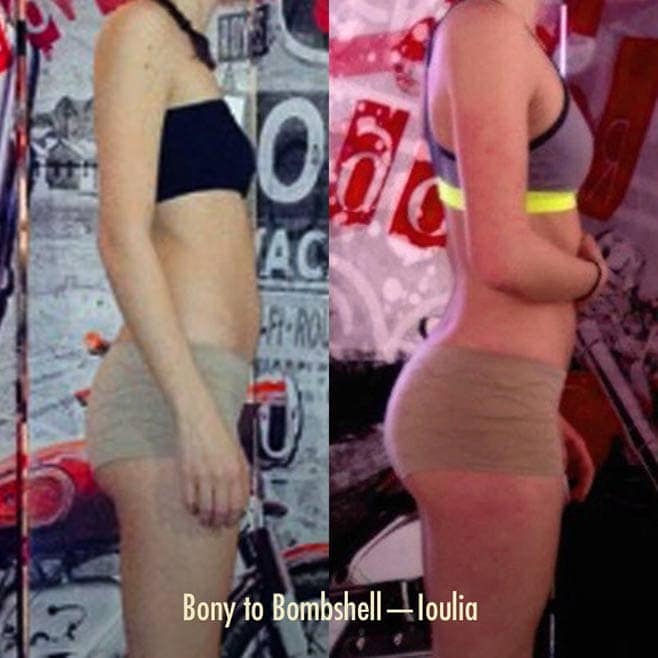
Ideally, you’d do the first workout early in the week (like Monday) and the second workout later in the week (like Thursday). It’s okay to do them two days in a row, though, even if you’re sore. Your results will be almost as good. The important thing is to do them.
Both workouts are full-body workouts, but they each have different exercises. The first workout has the squat and Romanian deadlift, whereas the second workout has the deadlift and split squat. Both work all the muscles in your legs, just with different exercises. That will give you a more balanced physique.
Start with fewer sets. Full-body workouts can be pretty long. You might need to cut the sets short to get through them. Start with 2-3 sets per exercise and work your way up from there.
Full-Body Workout 1
We’ve organized these exercises so that you can do supersets. For example, if you have two dumbbells, you can do a set of goblet squats, rest for a minute, do a set of one-arm overhead presses, rest for another minute, and then do your second set of squats. This is optional.
| Exercise | Sets | Reps |
|---|---|---|
| Goblet Squat | 3–5 sets | 6–10 reps |
| One-Arm Overhead Press | 3–5 sets | 8–15 reps/side |
| Romanian Deadlifts | 3–5 sets | 6–12 reps |
| Push-Ups | 2–4 sets | AMRAP |
| Step-Ups | 2–3 sets | 8–12 reps/side |
| Side Planks* | 2–3 sets | 10–20 seconds/side |
*Side planks aren’t just an oblique exercise. They’re also one of the few exercises that work the smaller glute muscles, giving you fuller hips. If you don’t care about that, I’ll give you some exercises for other muscle groups.
This workout focuses on your chest, back, quads, and shoulders. I’ve chosen pairs of exercises that are easy to superset, but choose whatever exercise variations suit you best. Here are my favourite swaps:
- Goblet Squat: back squat, front squat, or split squat.
- One-Arm Overhead Press: barbell overhead press or machine press.
- Romanian Deadlift: dumbbell Romanian deadlift, good morning, or leg curl.
- Push-Ups: dumbbell bench or barbell bench.
- Step-Ups: donkey kick or hip thrust.
- Side Planks: dumbbell farmer carries, lateral raises, dumbbell curls.
Full-Body Workout 2
| Exercise | Sets | Reps |
|---|---|---|
| Chin-Up | 3–5 sets | AMRAP |
| Split Squat | 3–5 sets | 8–12 reps/side |
| Deadlift | 2–3 sets | 6–10 reps |
| Push-Ups | 2–3 sets | AMRAP |
| One-Arm Row | 2–3 sets | 8–15 reps/side |
| Single-Leg Hip Thrust | 2–3 sets | 10–20 reps/side |
This workout focuses on your back, chest, hips, postural muscles, and arms. Here are my favourite exercise swaps:
- Chin-Up: pull-up, lat pulldown, or dumbbell pullover.
- Split Squat: goblet squat, front squat, or leg press.
- Deadlift: sumo deadlift, dumbbell step up, or good morning.
- Push-Ups: raised push-ups, deficit push-ups, or dips.
- One-Arm Row: bent-over barbell row, seated cable row, or t-bar row.
- Single-Leg Hip Thrust: barbell hip thrust, glute bridge.
Supersets
2-day splits usually have quite a few exercises in each workout, so it’s important to keep your pace up. One way to do that is to use short rest times, which we’ll talk about in a moment. The other way is to use supersets, where you alternate between different exercises, like this:
- Deadlifts, set 1. Rest a minute (or less).
- Push-ups, set 1. Rest a full minute.
- Deadlifts, set 2. Rest a minute (or less).
- Push-ups, set 2. Rest a full minute.
You need at least 2–3 minutes of rest between sets of deadlifts. With supersets, those muscles still get the rest they need, but you’re doing your push-ups while you wait. This makes your workout about 33% shorter. It also keeps your heart rate higher, which is great for your cardiorespiratory fitness.
The only downside to supersets is that they’re inconvenient. If you train in a crowded gym, it’s hard to hog the bench press and the squat rack. If you train at home, you might not have enough equipment to set up multiple big exercises. So, it’s better to combine exercises like deadlifts and push-ups, which don’t add any extra equipment. Squats and chin-ups also pair well.
If you can make it work, I highly recommend supersets. They aren’t mandatory, though. They won’t affect your muscle growth. More on supersets here.
Rest Times
Full-body workouts can run long, so it’s helpful to be strict with your rest times. We recommend 3 minutes of rest on the big compound exercises and 1–2 minutes on the smaller exercises. If you can’t time your rest times, pace around until your breathing is almost back to normal.
If short rest times make you nauseous or if you enjoy marathon workouts, you can extend the rest times. Extending the rest times won’t affect your muscle growth. More on the rest times here.
Reps in Reserve
You don’t need to take your sets all the way to failure, but you have to get close. You aren’t training very often, so you have plenty of time to recover. Better to push yourself harder.
I recommend getting within 2 reps of failure squats, deadlifts, and bench presses. You can push your other exercises within 1 rep of failure and take the last set all the way to failure (if it feels safe to do so). More on reps in reserve here.
Progressive Overload
Progressive overload is the idea that when you challenge your muscles, they grow bigger, stronger, and tougher. Thus, to continue challenging your growing muscles, you need to lift progressively heavier weights, do more reps, or find another way to make your workouts more challenging:
- Add a little bit of weight. Add 2.5 pounds to either side of the barbell. Go from the 20-pound dumbbell to the 25-pound dumbbell. Raise your feet up when doing push-ups.
- Fight to squeeze out more reps. If you got 10, 9, and 8 reps in your three sets, that’s 27 total reps. Try for 28+ reps next time.
There’s another side to it, too. If you’re able to lift more weight or get more reps than last week, then it shows you’ve gotten stronger. That’s a great sign of progress. If you aren’t making progress, you probably need to train harder, add more volume, get more sleep, or fix your diet.
How to Eat for Muscle Growth
You can use a 2-day workout routine to bulk, cut, recomp, or maintain. It’s a balanced routine that will stimulate muscle growth all through your body. To make the most of it, though, you need to eat in a way that supports muscle recovery and growth:
- Eat at least 0.7 grams of protein per pound of body weight per day. You only need about 0.4 g/lb/day for general health, but it helps to eat a little more when you’re being active and/or lifting weights. More here.
- Eat a balanced mix of carbs and fat. Low-carb diets can be good for losing fat. Moderate-to-high carb diets are often better for improving weight training performance, cardio performance, and muscle growth. I recommend eating a balance of both. Full research breakdown here.
- Eat nutritious foods. You probably have a good intuitive idea of which foods are healthy. Think of foods like fruits, veggies, lean meat, fatty fish, whole grains (including oats, corn, brown rice, quinoa, etc), beans, nuts, seeds, avocados, yogurt, cheese, olive oil, dark chocolate, coffee/tea, and plenty of spices. We have recipes here.
If you’re really trying to prioritize muscle growth, I wrote a full article on how to eat a bulking diet.
You don’t need to track your calories, especially if you’re maintaining or recomping. The simplest approach is to weigh yourself every week to see if your weight is moving in the right direction. If it isn’t, eat a little more or less. Keep adjusting until you’re getting the results you want.
If you want to track your calories and macros, we have a beginner’s guide to tracking. We also have a bulking calorie calculator, a cutting calorie calculator, a recomp calculator, and a maintenance calculator. If you want a calorie-tracking app, we recommend this one.
Alright, that’s it for now. Good luck!



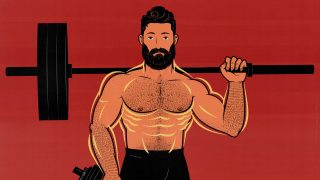
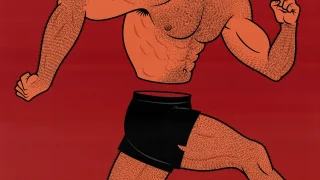
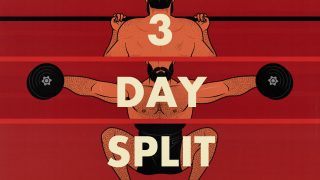
Every time I read one of these articles I achieve a little brain hypertrophy. Thanks!
I tend to do 3 day workouts but every now and then drop down to 2 in a busy week. I structure my 3 day workouts similar to how you to the 2 day split: try to hit all the major muscle groups in each workout but use different exercises on different days. Is that a good principle to apply to a 3 day split or is it better to ONLY train a given muscle groups twice in a week. In other words: does it matter how the volume is distributed throughout the week or simply that the target volume for each muscle group is achieved?
Thanks, Darren!
You can keep doing a 3-day split when you drop down to two workouts per week. 3-day full-body splits make really good 2-day splits. You just have 3 full-body workouts in the rotation instead of 2. That extra variety can be nice. (You can also do 2-day split 3x per week, but that often means needlessly missing out on some useful variety.)
3-day workout routines usually train most muscles most workouts, but they don’t have to. Training a muscle 2–4 times per week seems to be best for building muscle, so you’ve got options. You could drop the frequency down to 2x per week. That can be good if your full-body workouts feel too taxing.
I’m working on the 3-day article now. It’s almost done. I’m hoping to get it published tomorrow.